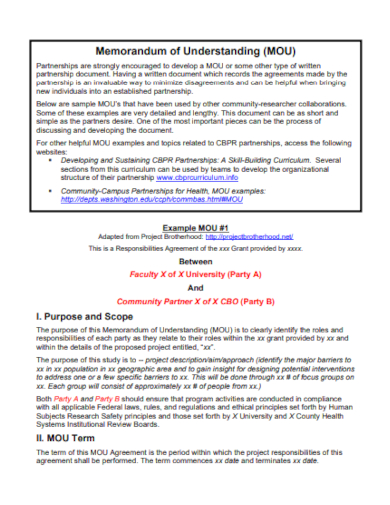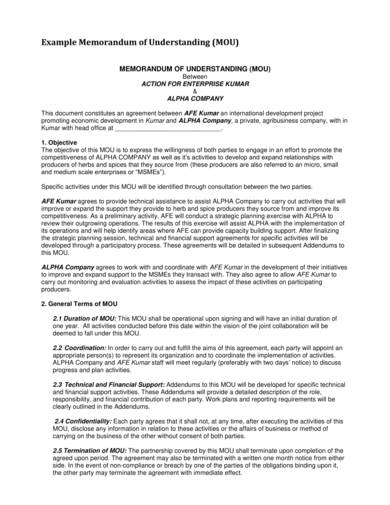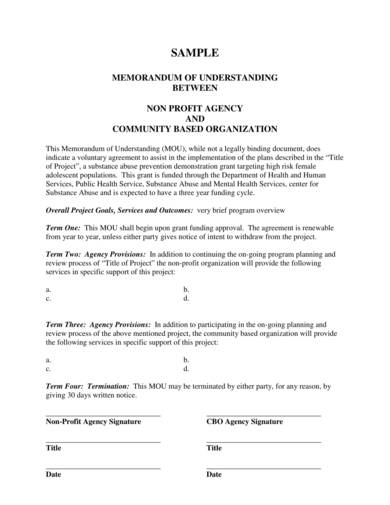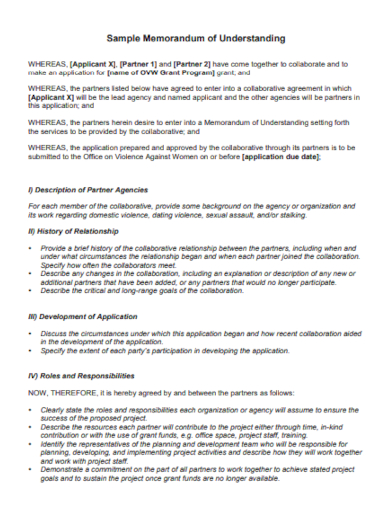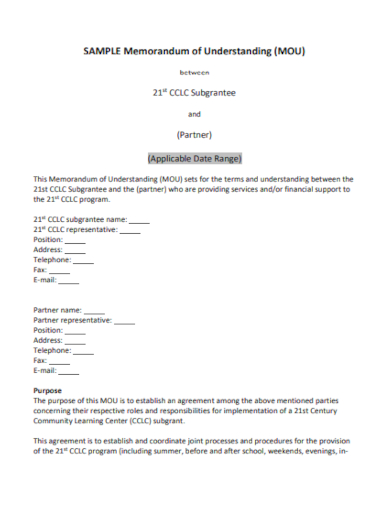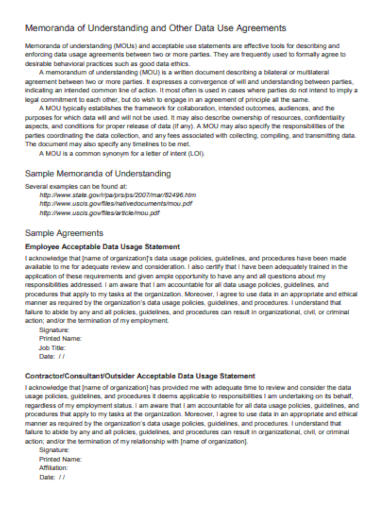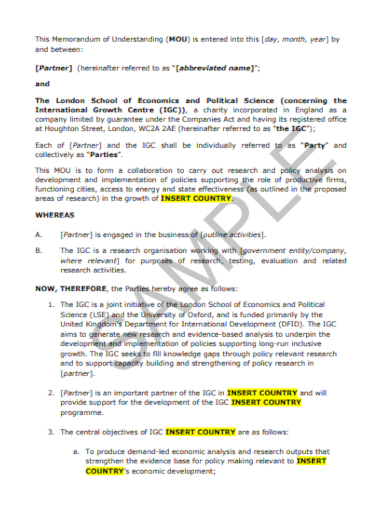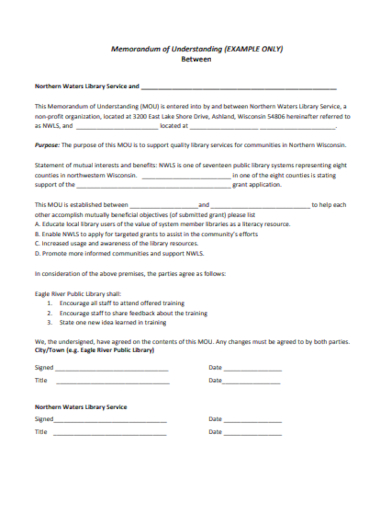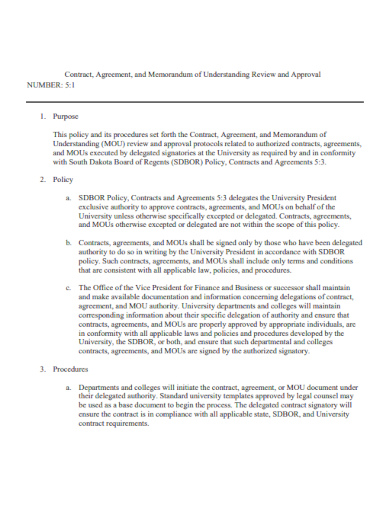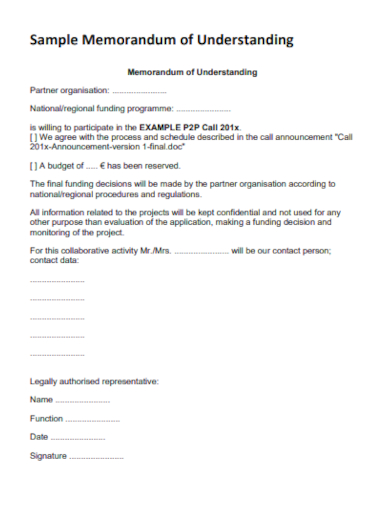A memorandum of understanding is a formal contract agreement between two or more companies or parties that outlines the key terms and conditions that they will later incorporate into a formal contract. This memo is not legally binding but shows the willingness of each party and helps in ensuring that they are all operating on the same page. It also resembles the content of a legal contract and can be turned into one, making it enforceable.
FREE 10+ Memo of Understanding Samples
1. Restaurant Memorandum of Understanding Template
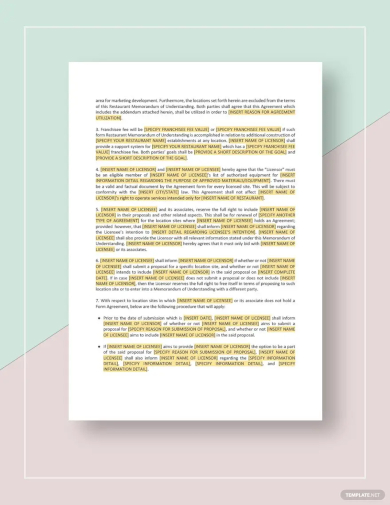
2. Memo of Understanding
3. Sample Enterprise Memorandum of Understanding
4. Short Memorandum of Understanding Sample
5. Applicant Memo of Understanding
6. Standard Memo of Understanding
7. Memo of Understanding Data Agreement
8. Partner Memo of Understanding
9. Service Memo of Understanding
10. Contract Memo of Understanding
11. Organisation Memo of Understanding
What is a Memorandum of Understanding?
Despite the fact that it is not legally enforceable, a memorandum of understanding or MoU is an agreement between bilateral or multilateral parties written in a formal document. This can also be seen as the beginning of negotiations as it provides the definition of its purpose, the scope of work, and its limitations. This memorandum is often used for international treaty negotiations but can be also used in high-level business negotiations such as mergers and acquisitions. MoU is usually created by government entities, non-governmental organizations, and corporations when they are working with other companies to record terms and conditions, negotiations, and transactions.
How to Write a Memorandum of Understanding?
A memorandum of understanding is created when two parties want to keep a record and write down the general understanding of the potential transactions they want to engage in. This document expresses the intention and agreement of the parties to proceed, making it clear that they have reached an understanding and are moving forward with the formal agreement they had established.
Step 1: Determine the Memorandum’s Topic and Title
Choose a title and topic that reflects the type of memorandum of understanding you are using. You also have to provide the basic details of the parties involved at the beginning of the document like their names, contact information, and addresses.
Step 2: Include Initiation and Termination Details
An effective memorandum of understanding should contain the effective date of the document when the work will begin, and the terms under which the document can be terminated. If the memorandum is a one-time contract agreement with a fixed target date, it is important that you include the date of the termination. You should also include the description of the project, the roles and responsibilities of the team members, business goals, milestones, and deadlines.
Step 3: Determine the Key Stakeholders
The MoU should also mention the project’s key stakeholders, collaborations, or partnerships. Outline the terms of a partnership or collaboration, and deadlines for deliverables, and make sure that all parties are informed about it and that they understand each of their timeframes.
Step 4: Provide the Terms and Provisions
If the project, collaboration, or partnership includes any special requirements to add terms of finishing the project, it should be included in the work statement of the MoU. After completing these steps, the document must be signed and dated by both parties to reflect the understanding between them.
FAQs
What are the different types of memorandum of understanding?
The different types of MoU are Joint Venture MoU which include Contractual Joint Ventures and General Joint Ventures. There’s also the Service Agreement MoU, Outsourcing MoU, Asset Purchase MoU, Share Purchase MoU, and Business Relationship MoU.
What is included in a memorandum of understanding?
The key elements of an MoU are an outline of the parties’ points of understanding, terms and conditions that both parties agreed upon, details on all parties involved, the purpose of the agreement, and the signatures of all the parties.
When do you use an MoU?
An MoU is commonly used when an individual owns a business and intends to form a partnership with another business, owns a small business and regularly partners with other businesses, another business wants to work with their business, and if the individual’s company and another business wants to collaborate on a specific business or project proposal together.
A memorandum of understanding or MoU is a formal document that provides a clear description of the broad outlines of a contract agreement between two or more parties while also making sure that they have a mutual understanding of the expectations of all parties involved in a negotiation. A Mou is not legally binding but can be a declaration that a contract is impending. Like a letter of intent, an MOU communicates the agreement on a beneficial goal and the intention of seeing it through to completion.
Related Posts
FREE 10+ Management Memo Samples in PDF | DOC
FREE 6+ Mutual Agreement Samples in MS Word | PDF
FREE 14+ Memo Writing Samples and Templates in PDF | MS Word
FREE 13+ Business Memo Templates in MS Word | PDF | Google Docs
FREE 15+ Memorandum Samples in MS Word | PDF
FREE 10+ Strategy Memos in MS Word | Google Docs
FREE 8+ Executive Memo Templates in MS Word | Google Docs
FREE 6+ External Memo Templates in MS Word | PDF | Google Docs
FREE 8+ Bid Memo Templates in MS Word | PDF
FREE 8+ Notice Memos in PDF
FREE 9+ Budget Memo Templates in MS Word | PDF
FREE 8 Board Memo Templates in PDF
News Report
Written Warning
Teacher Lesson Plan

